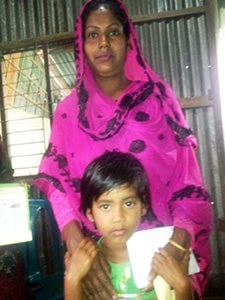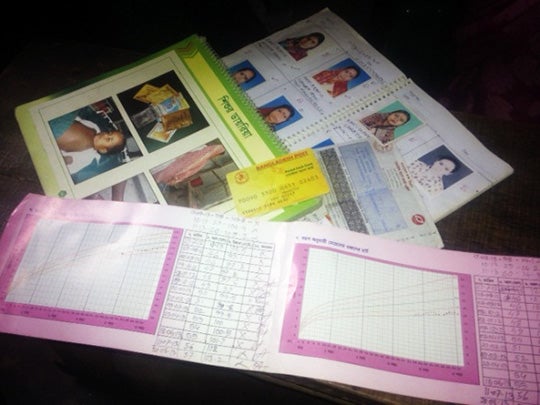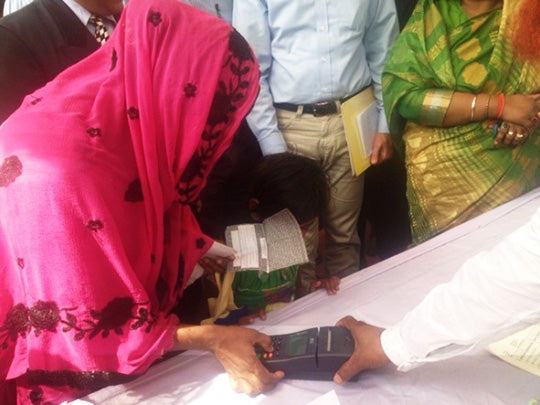
For the last 15 months, Sima has started receiving nutritional advice as well as a small cash transfer to help raise healthy children. Through a pilot cash-transfer program supported by the Rapid Social Response Multi-Donor Trust Fund (MDTF), her 10 year old son Faisal, is eligible for a Tk 800 ($10) school stipend and her daughter Shakal, 5, for a Tk 800 income transfer. Sima uses the stipends to feed Shakal a healthier diet and to pay for Faisal’s tuition, school books and uniform.
In order to receive these stipends Sima has to ensure that Faisal goes to school and that Shakal is brought every month to the community center near her house at New Zimkhana, where her growth can be monitored. The growth monitoring is simple:

After Shakal’s check-up, Sima presents her Bangladesh Post swipe card to a post office clerk who runs it through a point-of-sale reader. When she confirms her identification by entering her PIN number, she gets her Tk 1,600 stipend. Asked what she did to promote Shakal’s growth, Sima said: “I use the money to feed Shakal eggs, apples and Horlicks,” a locally-produced fortified malt drink.
Sima also receives food tips from the community workers –Amina, Nargis, and Nasrin—who run the center. The workers hold food education sessions that use pictures to help young mothers like Sima learn what foods are good for young children and equally important, what are not good. Like many poor people, young Bangladeshi women are sometimes enticed to believe that fancy packaged foods, associated with the rich, are more nutritional than the non-packaged fruits and vegetables. The fact is that the packaged foods, heavy on sugar and oil, are often both expensive and not nutritious. On an average day, about 50 or 60 mothers bring their children to the center for monitoring and advice.
A recent evaluation of this pilot program found that mothers were encouraged to include more protein in their children’s diet to improve their growth. By contrast, the evaluation showed that the school stipend did not seem to make much difference in attendance, possibly because there are already other programs supporting primary school students and parents. In addition, it was hard for the program to monitor school attendance.
The evaluation also revealed that internal migration could undermine the program as many young mothers living in urban slums do not stay in the same place for long. Concerned that the dropout mothers and children were no longer following the nutritional program, Amina, Nargis and Nasrin decided to expand their database.
“We put together a booklet that contains a photograph, program ID number and mobile number for every participant,” said Nasrin. Thanks to their initiative, they are now able to track the dropouts who have cell-phones to help them even if they leave the program area.
In an effort to improve financial security and childhood nutrition among the poor on a larger scale, the World Bank is now preparing a $300 million project to help the Government of Bangladesh scale-up the pilot program to 26 upazilas (sub-districts) and two municipalities, including Narayanganj. Of course, the program’s feeding practices are only one intervention out of many needed to bring about a decisive improvement in nutrition—and so the Government of Bangladesh and development partners are also working with the health, agriculture, education, and water and sanitation sectors to reduce malnutrition.
It is clearly too early to declare victory in the fight against poverty and malnutrition in Bangladesh. Even so, cash transfers conditioned on growth monitoring and nutritional learning may make an important contribution over time.
Caption 1: Shakal and her mother, Sima, at the community center in New Zimkhana
Caption 2: A few simple materials used to monitor a child’s growth
Caption 3: Sima entering her PIN number at the point-of-sale
Photos by Iffath Sharif/World Bank


Join the Conversation